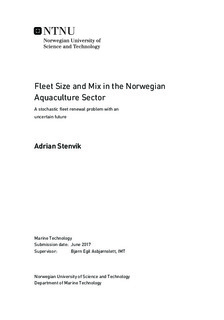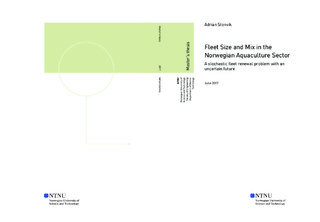| dc.description.abstract | The aquaculture sector in Norway aims to increase the production five times by 2050. For this aim to be reached it is likely that new solutions relating to the future service needs of the sector need to be developed. To support such a development, it could be of value to have a decision-making support tool available when strategic fleet renewal decisions are to be made. Such a tool should also be able to consider future uncertainty when the decision is made.
The aim of this study has therefore been to propose a modelling approach for such a decision-making support tool.
In this study, the focus has been on well-boats and service vessels, and the tasks these vessels are needed to service in the Norwegian aquaculture sector. Important service tasks have been identified, and an estimated demand and time consumption for the tasks have been established along with some possible future developments in the sector.
Some previous work on maritime fleet renewal problems (MFRP) have been reviewed, and a two-stage stochastic programming model for the MFRP in the aquaculture sector has been presented. The model aims to minimize the total cost incurring when acquiring and operating a fleet of vessels. The demand is assumed to be known for the first set of time periods, while the demand in the second stage is illustrated by a set of scenarios. Vessels can be bought and sold in all time steps in both the first and second stage of the model. The first stage makes sure that the here and now decisions are equal for each scenario, and the scenarios are included to make the here and now decisions more robust with respect to future uncertainty. All routing decisions have been taken out of the optimization model and moved to a separate loop generator to ensure a simpler structure of the optimization model, and to ensure flexibility in the modelling approach.
The optimization model has been implemented in the commercial solver XPRESS IVE and the loop generation is done in MATLAB. To test the model`s performance, a test case with eight time steps and four scenarios was solved and the value of the stochastic solution was found. The case study finds that the model choses a fleet composition which seems reasonable, and that the solver can solve the problem within an acceptable amount of time. The test instance shows a low value for the stochastic solution, indicating that for the particular case a deterministic model could be just as effective. However, the stochastic solution gave a more flexible solution, as the deterministic approach found no feasible solution for one of the scenarios.
The model presented in this study provides a good basis for further development of maitime fleet renewal models in the aquaculture sector, and can be seen as a flexible modelling platform which can easily be altered to include new tasks, new vessels or new acquisition and disposal methods for vessels in the fleet.
This modelling platform could be applied by salmon producers wanting to reduce the cost of servicing the demand of their farming locations. Then the model could be used to include all their current and planned locations. Furthermore, the model could be of interest to a ship owning company with a long-term contract with a salmon producer or who just wants to evaluate how the future demand for vessels might be, to be able to buy the right vessels at the right time. | |

